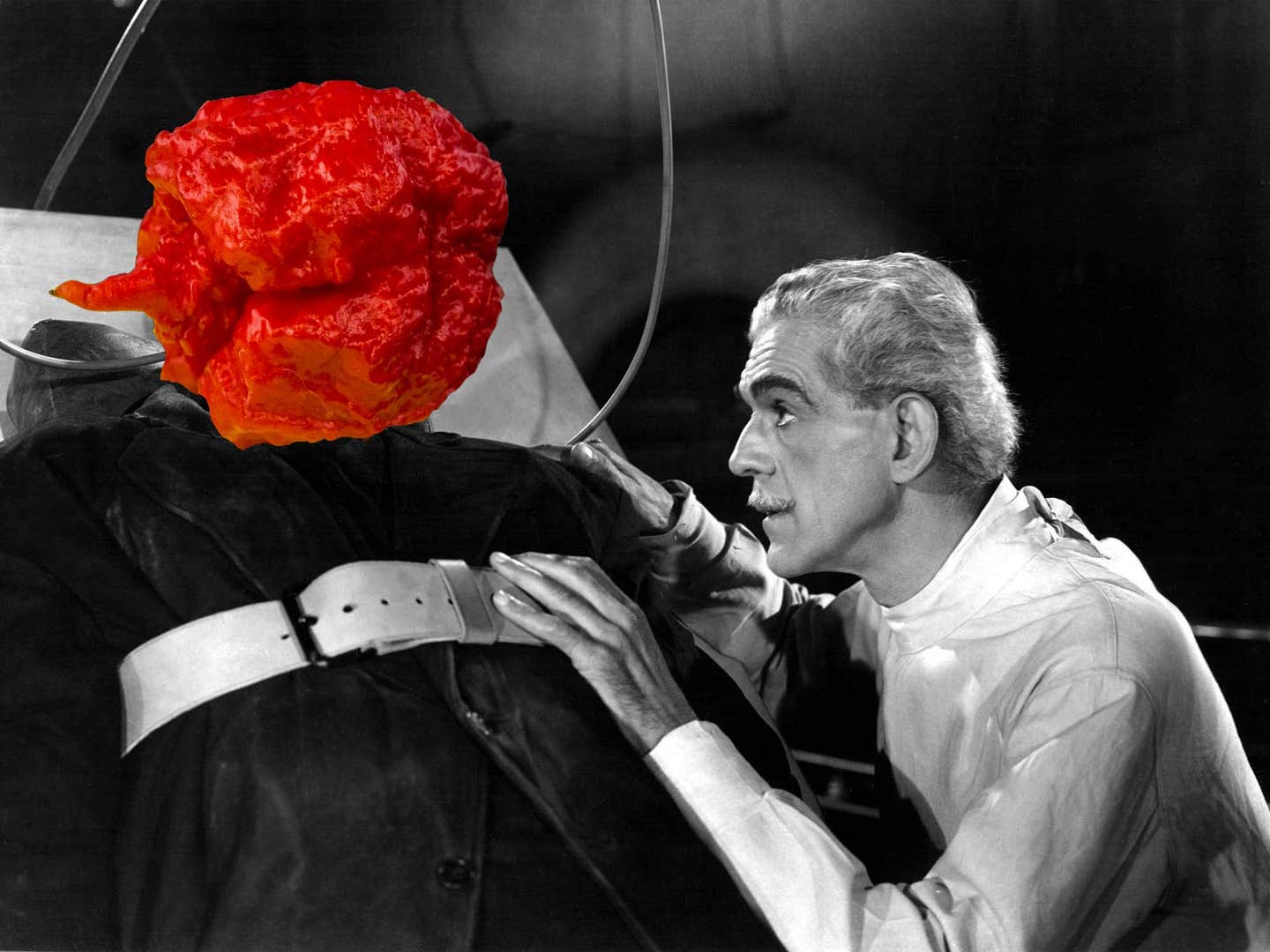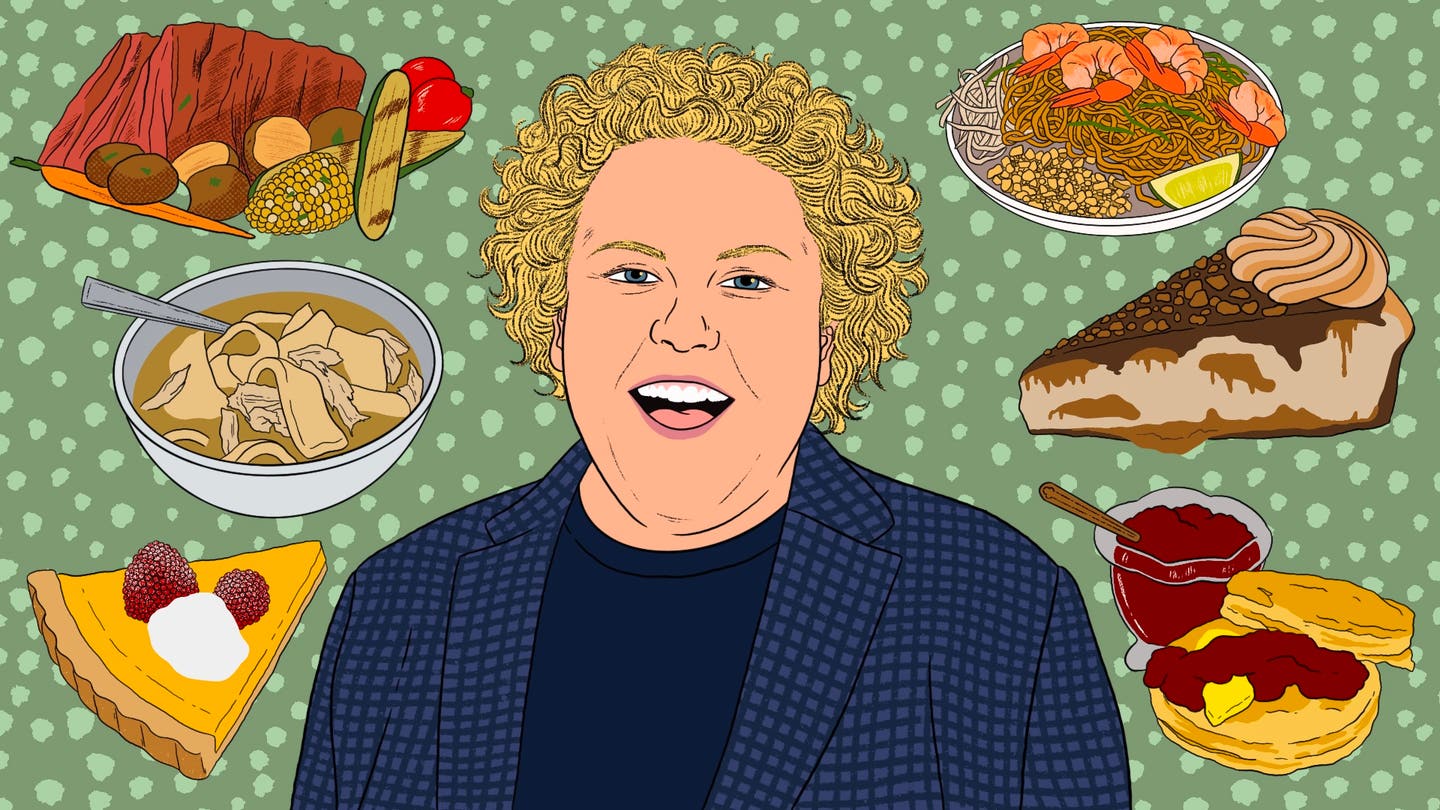
Flavor Tripping on the Pepper So Spicy It’ll Give You Visions of the Cosmos
Don’t fear the Carolina Reaper, a chile 400 times hotter than a jalapeño
The Carolina Reaper was supposed to be the hottest pepper in the galaxy. It was specifically bred to torch taste buds with heat more than 400 times more potent than that of an average jalapeño. Biting into a Reaper waters your eyes, coats your tongue with an odd mintiness, and like other more-illicit substances, shimmers the dogs and lamps in the world around you.
The Reaper was supposed to be an endpoint in pepper breeding. For many years it was the DiMaggio 56-game hitting streak of the vegetable world: a record never to be broken. But this year, a new superhot known as the Dragon’s Breath Chili has been developed in Wales.
Why do people fiend for such heat? Why do breeders breed it? Why, two decades ago, when the Red Savina was the world’s hottest chile and the ghost pepper was first encountered by Western heat-seekers in India, did we haul the ghost out of the jungle and, unsatisfied with its solar heat, cross it with other chiles to create even hotter ones?
Superhots like the Carolina Reaper are rumored to offer more than heat; advocates claim they grant access to strange and elusive flavor dimensions. I have heard of subtle citrus and chocolate notes. So do superhots provide ephemeral flashes of beauty before the conflagration? If they do, how can we use them to make food taste better? Or is masochism the whole superhot story?
Strap on your gas mask and pour a frosty glass of milk. We’re about to find out.
The first, most obvious explanation is that spicy food gets you kind of high. Science tells us that capsaicinoids—the chemicals that make food burn—interface with nerve cells on the tongue, summoning the sensation of heat. This sends pain signals to our brains. The brain responds by releasing endorphins (blocking pain signals) and dopamine (ahhhhhhhh). But that effect is easily achievable with peppers you can buy at the grocery store. It doesn't explain why we need a pepper that makes a jalapeño taste like a sugar cube.
Second stop: the mind of the breeder. A curious man named "Smokin'" Ed Currie created the Carolina Reaper. Currie helms the South Carolina-based PuckerButt Breeding Company. In 2004, Currie crossed a Pakistani Naga with a Red Habanero, Frankensteining the Carolina Reaper into volcanic existence. Guinness, the unofficial arbiter of heat in the pepper world, announced that the Reaper had supplanted the Trinidad Moruga Scorpion as the world's hottest. Currie admits he was targeting what the Reaper ultimately delivered: heat, pure and lobotomizing, heat beyond what any other pepper could attain.
“I was eating ghost peppers and stuff at the time I first made the Carolina Reaper,” he proudly recalls. “When I ate the Reaper, it made me high. That’s how I knew this one was really special.”
Currie encourages people to eat Carolina Reapers, record the torture, and post the evidence online. He licenses intellectual property related to the Reaper out to other growers. He touts the curative properties of the Reaper, even speaking about “health benefits” and the “medical community.” Clearly, such a molten pepper is marketing gold. How much better does “world’s most volcanic pepper” sound than “world’s sixth-hottest chile?” The race for heat, in part, overlaps with the race for cash.
Third stop: maybe peppers like the Reaper make superlative hot sauce.
"With the Reaper, heat is the main goal," says Dylan Keenan, who with his wife Becky owns Heat Hot Sauce Shop in Berkeley, California. "But you get other flavors—a subtle cinnamon flavor, a little smoky, a little citrusy, kind of fruity..."
Wait a minute. Citrus? Fruit? How can Keenan’s taste buds glean anything when the tide of fire is so high?
“You won’t be able to taste these flavors unless you develop a tolerance and get used to the heat,” he explains, referring to chomping into raw Reapers before they are used in hot sauce. “This takes anywhere from a few months to a few years.”
Eating a whole Reaper is no answer to the question of flavor for a person with a mortal palate. But one does not need to eat a whole pepper to enjoy sauce made from that pepper. Hot sauces bring range. They may be only a few percentage points pepper, or may be as much as 70% pepper or more. Do hot sauces supply the answer?
The line of thinking is this: take a superhot. You need less of that superhot to make a sauce spicy than you would a milder hot pepper, such as a Serrano. Because we can start with less pepper, we have more space in the bottle for other ingredients: carrot, lime juice, dehydrated celery, allium, fruit purée... any conceivable substance that tempers heat and sculpts flavor.
“When you’re making a hot sauce, you’ve got to balance the heat,” Keenan says. Cobra Chilli in Australia does an Asian-style hot sauce with miso and sesame oil and a mild-ish 5% Reaper. CaJohn Fiery Foods in Ohio blends a hotter 51% pepper sauce—Reaper and ghost—tempered with cider vinegar, tomato paste, and lemon juice. Heartbreaking Dawns in Arizona concocts sauces from the Moruga Scorpion and Reaper, artfully sculpting the throat-to-tooth blaze with flavorings like honey, apricot preserves, and orange marmalade.
Some superhot sauces are great—and some are inedible. But do we taste the nuances of the Reaper and other superhots in them? How can one separate flavor triggered by the addition of lemon juice from the purported natural citrus notes of the pepper, a Reaper’s rumored cinnamon from added spices? We cannot! And further, sauces that lean too heavily on the Reaper bring mere volcanic heat.
Four: Does a superhot pepper serve some utility in the kitchen?
Maricel Presilla is a chef, author, winner of three James Beard Awards, and author of the just-released authoritative tome Peppers of the Americas. She grows 300 kinds of peppers in her Weehawken, New Jersey garden. One kind, she says, is the Carolina Reaper.
She echoes Keenan. "There are incredible nuances in the Capsicum chinese family," she reveals, referring to the family of chile that includes the superhots. "If you care about flavor, use a sliver of pepper. The reality is that heat is only as good as what it can do to food: bring out other flavors."
She adds: “With superhots, the capsaicin levels are so high that you can’t dwell on flavor much. It’s hard to tell the flavors.”
Using just a sliver of pepper allows Presilla to cook with superhots. She likes to combine a superhot and a milder hot pepper. For ceviche, she typically keeps things in the Capsicum chinese family, looping in the heat and flavor of three peppers: cachucha (a sweeter Caribbean pepper), charapinta (a floral Amazonian pepper), and a potent superhot like the Trinidad 7 Pot or Carolina Reaper. By using no more than a sliver, Presilla can channel the Reaper's flavor without obliterating all others.
Okay. So—swabbing our tongues with some bread, stripping off our latex gloves—what answers have we gathered? The unceasing quest for hotter and hotter peppers serves a few purposes: marketing cache; restrained use in hot sauces of exceptional quality; and careful use of slivers in cooking. There has to be more to this story.
Five: We turn to the Carolina Reaper.
Standing in my kitchen one spring day, I held a single reptilian Carolina Reaper in my palm. The superhot pepper was red as fire truck, which, given what I was about to do, may have been needed to extinguish the flames.
The round face is not only red but wrinkled. Gnarled even. Gnarled with so many tiny mountain ridges that when you look into the eyeless face, you are struck by its supreme ugliness. This? Yikes! Your outraged eyes trace the shape: like a deformed pumpkin, the bottom tapering to an insect-tail-like point, giving the Reaper a shape like the weird tears we are about to cry.
The pepper seems to ripple and warp the air around it. A smell part rotten fruit, part vegetal strangeness rises. The Reaper’s red grooves and furrows shine. Even with its glisten, the Reaper radiates dark vibes. It looks like it grew on a gaunt tree in hell; it’s so hypnotically ugly that it’s beautiful. Anticipating napalm, straining to comb out those elusive flavors, I lop off the lower fifth and knife the pepper’s scorpion tail into my mouth.
Heat? Heat. Fruit nuances? Vegetable traces? Something, yes! What? Can’t tell. Because the heat starts off low and strong. It steadily rises and rises, rises and rises. You think it can’t rise any more. Still it rises! It’s remarkable how long the build up lasts, how long the hellaceous rollercoaster clacks skyward, how long the firestorm takes to rage to full inferno. Forty seconds. No—a full minute! And then the Carolina Reaper tops out at full pulsating blaze.
The roof of your mouth feels raw, blasted by a polar wind. Each breath sends the blue flame of a blowtorch leaping up your throat. There is no finesse. Only power. The edges of reality have an ethereal sheen. As the capsaicin needles your tongue, as the napalm pours down your throat, your brain releases chemicals that give consciousness a nice lightness. The heat of the Reaper, somehow, is endurable!
Extreme heat puts you outside yourself.
You start to ponder again.
Why do people crave such heat? Why do people go through all the trouble?
There is no truly good use for superhots other heat for heat’s sake. The answer to this question, then, has roots in the same incurably restless itch that 500 years ago sent humans on boats to the unmapped corners of the world and 50 years ago propelled people in tin cans to the moon. When we seek extreme heat, we voyage to the far side of human experience, to the outer boundaries.
Keep Reading
Continue to Next Story










